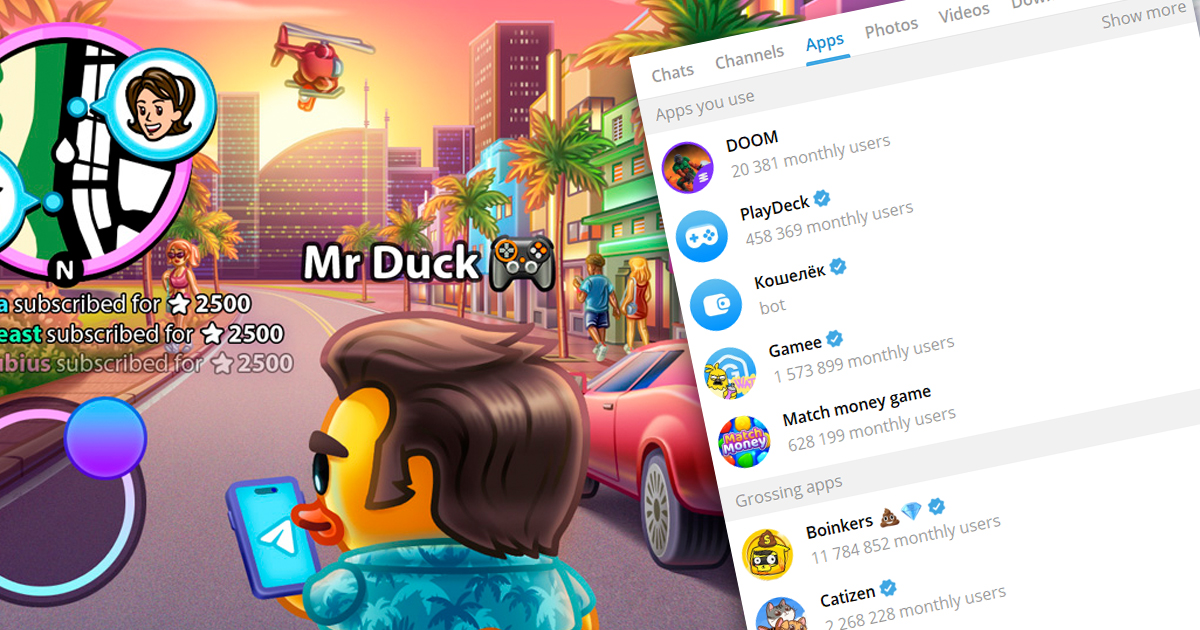Inside Telegram Mini Apps platform: key features, monetization, and biggest releases
Last year saw a series of major crypto game releases on Telegram. Writing for Game World Observer, TON Society‘s Alexey Toropov and AdsGram‘s Vadim Sterlin explain what the state of the Telegram Mini Apps platform, also sharing insights into the successful games.


Alexey Toropov (left), Vadim Sterlin (right)
Let’s start with the basics. Telegram Mini Apps is a platform for mini apps operating within the Telegram messenger, which had 950 million monthly active users as of July 2024.
Advantages
Key strengths of the platform include:
- Tools to launch games quickly (no lengthy moderation, as in the Apple App Store or Google Play);
- Access to Telegram’s massive user base.
Another frequently mentioned benefit is the lack of commission fees. While app stores charge up to 30%, Telegram takes 0%. However, there’s a catch here, which we’ll discuss in the monetization section.
Capabilities
Today, developers can provide a fully native experience for players in Telegram Mini Apps. Last November, the platform introduced the following updates:
- Full-screen mode support (both vertical and horizontal screen positions);
- Ability to add mini app icons to the home screen;
- Access to motion trackers and geolocation;
- Customizable loading screens.
As a result, even games like Doom can now run on the platform.
Monetization
Within Telegram, users can pay third-party developers using:
- Bots;
- The Stars currency;
- The TON cryptocurrency wallet.
For games, the latter two options are most relevant.
Stars
Stars are Telegram’s official in-app currency. Users buy them with real money via mobile payment systems or bots. Withdrawals are only possible through TON.
And here’s the catch with the “zero commission” point.
The exchange rate of Stars is a separate complex topic. On the one hand, they are withdrawn at the rate of $0.013 per Star. On the other hand, the price for them depends on the selected currency and the volume of purchase (the more you buy, the cheaper they are).
As a result, the IAP for 100 Stars in the game can cost the user $2.4, but the developer will be able to withdraw the same amount only as $1.3.
However, Stars remain a convenient payment tool within Telegram, enabling:
- Unlocking premium app features;
- Purchasing in-game items and upgrades;
- Subscribing to apps.
In December 2024, Telegram also introduced Affiliate Programs, allowing users and channels to earn Stars by referring paying users to mini apps (for a percentage of referred users’ payments).
TON
The TON cryptocurrency can also be used for microtransactions, but this is rarely utilized.
Case studies
Last year’s viral hits — Notcoin, Hamster Kombat, and X Empire — attracted hundreds of millions of users combined.
It is worth noting that all successful cases in the niche so far are crypto-linked. Their lifecycle typically follows this pattern:
- Developers launch a game, promising players that they will be able to convert in-game currency to crypto or real money;
- Aggressive advertising drives massive user growth, though 80% of “users” could be bot farms (so-called drop hunters) focused on earning money from such projects;
- The game’s token is listed;
- In most cases, the player earns only a few dollars after several months of playing the game;
- The audience loses interest in the game and it slowly dies.
Below are examples of such flash-in-the-pan games.
Notcoin: the success story that started the clicker craze
Notcoin became a phenomenon and inspired countless clones.
Key facts:
- Launched as an experiment in January 2024, gaining a strong player base;
- Hit 1 million users in two days, crossing the 4 million mark in its first week (at that time it was considered the fastest-growing Web3 game);
- Reached 35 million players by May 2024.
Mechanics:
- The game has a low barrer to entry and very simple mechanics: the user clicks on a large yellow coin in the center of the screen, earns virtual currency, which can be spend on various boosters (e.g. multi-clicks or auto-clicks).
Notcoin was the first to show that games on the Telegram Mini Apps platform can reach a large audience. The success of the game prompted other developers to create their own clickers.
Hamster Kombat: almost 300 Million users in record time
Hamster Kombat is likely the most famous Telegram game. Its popularity and hype has spread far beyond the Web3 community.
Key facts:
- Launched in March 2024, riding Notcoin’s successful listing;
- Hit 35 million users by April and crossed the 239 million mark by June;
- At its peak, the game attracted 4-5 million new users daily, earning praise from Telegram founder Pavel Durov as the “fastest-growing digital service in the world.”
Mechanics:
- The basic mechanics are similar to Notcoin: the player taps an object on the screen to earn coins (in this case, a hamster) and earn virtual coins;
- The game introduced a much deeper meta progression such as upgrades and various bonuses;
- Hamster Kombat devs added retention and virality tools inherent in mobile free-to-play titles (e.g. they ask you to subscribe to real groups on social media in exchange for coins).
Thanks to well-executed influencer marketing and good word of mouth, which would not have been possible without the focus on network marketing (the game also gave currency for acquired friends), Hamster Kombat became a global phenomenon in a matter of months.
X Empire: Hamster Kombat clone that achieved impressive reach
Managed by popular Russian YouTuber Alexander Sokolovsky, X Empire took on the rising social media presence of Elon Musk and the whole clicker trend.
Key facts:
- Released in July 2024, the game reached 52 million users in its first three months;
- After Donald Trump’s victory in the election, it was briefly the most traded token on the TON network, with its trading volumes reaching $316 million (note that the token’s price and its volume have now dropped to a minimum, as in the case of all other Telegram games that have gone through the listing).
Mechanics:
- X Empire is a Hamster Kombat clone, where the player taps on Elon Musk instead of a hamster, developing businesses of the controversial businessman;
- As in Hamster Kombat, the player has to upgrade plenty of in-game menus to increase their passive income, while also taking part in daily activities.
X Empire showed that it is possible to achieve impressive reach and attract millions of users even by releasing a clone of another product to the market.
Major: another 2024 app that bet big on met progression
Major is technically a collection of mini games, also offering users various tasks for maximizing the drop after listing.
Key facts:
- Released in July 2024;
- At the time of listing in late November, Major had 70 million users, with $10 million in revenue;
- The game peaked at 45 million MAU.
Mechanics:
- The game is built around the list of activities required to earn in-game currency — Stars (the drop after listing depended on the amount of Stars the player collected);
- Games aren’t the core element of Major, as the app offers users to share referral links, subscribe to a particular channel, and make a real payment (the more you transfer, the more Stars you get);
- Major has four mini games that are even more primitive gameplay-wise than hyper-casual titles;
- One of its innovations compared to competitors is the guild system: the player receives a penalty for not completing daily tasks (if you don’t log into the game for one day, you lost 5% of your earnings).
While not positioned as a full-fledged game, Major still attracted a huge audience at launch users and took a number of mechanics from live service projects.
Conclusion
The Telegram Mini Apps platform has quickly evolved from distributing simple clickers to supporting more complex products with affiliate programs and subscription models. As it continues to evolve, we are confident that the coming months will show its further rapid growth.